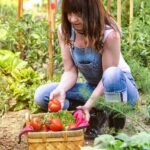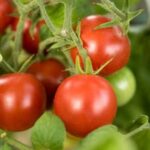Have you ever considered growing vegetables in recycled containers? Recycled container gardening vegetables offer an eco-friendly and space-saving option for urban dwellers and those with limited outdoor space. In this article, we will explore the world of recycled container gardening for vegetables, including its benefits and how to get started.
Recycled container gardening involves using everyday items such as old buckets, plastic bins, or even wooden crates to grow fresh produce. Not only does this practice reduce waste by repurposing items that would otherwise end up in landfills, but it also allows individuals to cultivate their own nutritious vegetables at home. Whether you live in an apartment or have a small backyard, recycled container gardening is a flexible and sustainable way to grow your own food.
For urban dwellers and individuals with limited outdoor space, growing vegetables in recycled containers opens up a world of possibilities. By utilizing vertical space on balconies or creating small, portable gardens, anyone can enjoy the benefits of homegrown produce.
Additionally, by repurposing containers that may have been discarded, gardeners are contributing to a more sustainable environment while reaping the rewards of their efforts. In the following sections, we will delve into the details of choosing containers, preparing them for planting, selecting suitable vegetables, and maintaining a thriving recycled container vegetable garden.
Choosing the Right Container
When it comes to recycled container gardening vegetables, selecting the right container is essential for the success of your vegetable garden. There are several options available for containers, each with its own benefits and drawbacks.
Different Types of Containers
There are various types of containers that can be used for recycled container gardening vegetables, including plastic pots, wooden crates, hanging baskets, and even old tires. Each type of container has its own unique features that make it suitable for growing different kinds of vegetables. For example, plastic pots are lightweight and easy to move around, while wooden crates provide a rustic look and good drainage for root vegetables.
Tips on Selecting the Right Size and Material
When choosing a container for growing vegetables, it’s important to consider the size and material of the container. The size of the container will determine how much space the plant roots have to grow and spread out, so it’s crucial to select a size that is appropriate for the specific vegetable you want to grow.
Additionally, different materials offer different levels of insulation and moisture retention, so be sure to choose a material that will provide a healthy environment for your vegetables.
By carefully considering the types of containers available and following these tips on size and material selection, you can ensure that your recycled container gardening vegetables have the best chance at thriving in their new homes.
Preparing the Containers
Step-by-Step Guide for Preparing Recycled Containers
Before starting your recycled container gardening vegetables, it is important to properly prepare the containers to ensure the health and growth of your vegetables. The first step is to thoroughly clean the containers, removing any dirt or debris from previous use. It is also essential to ensure that there are no toxic residues from the previous contents of the containers, especially if they were previously used for chemicals or other harmful substances.
Once cleaned, it is important to create proper drainage in the containers to prevent waterlogging and root rot. This can be done by drilling several small holes in the bottom of the container to allow excess water to drain out. Additionally, adding a layer of gravel or small rocks at the bottom can further improve drainage.
Importance of Soil Preparation
After preparing the drainage, it is crucial to fill the containers with high-quality soil that is well-draining and nutrient-rich. Using a mix of potting soil and compost can provide an ideal growing medium for your vegetables. Consider mixing in some perlite or vermiculite to improve aeration and drainage, which will help promote healthy root development.
Furthermore, adding organic fertilizer or compost into the soil mix can provide essential nutrients for your vegetable plants. By properly preparing the soil in your recycled containers, you can create a suitable environment for successful vegetable gardening.
Choosing the Right Containers for Vegetables
When preparing recycled containers for vegetable gardening, it is important to consider the type of vegetables you plan to grow and select suitable containers accordingly. For example, larger vegetables such as tomatoes or peppers may require deeper and larger containers, while smaller herbs or lettuce can thrive in shallower pots or window boxes.
It’s also important to consider material-plastic, ceramic, wood-and choose materials that are safe for growing food. Selecting an appropriate size and material for your specific vegetable plants will contribute greatly to their overall health and productivity while providing a sustainable gardening solution using recycled materials.
Selecting Vegetables for Container Gardening
When it comes to choosing the right vegetables for your recycled container gardening project, there are a few factors to consider. Not all vegetables thrive in containers, so it’s important to select varieties that are well-suited for this type of gardening. Here are some of the best vegetables to grow in recycled containers:
- Tomatoes: Compact tomato varieties such as cherry tomatoes or patio tomatoes are perfect for container gardening. They require minimal space and can be easily supported with a cage or trellis.
- Peppers: Both sweet peppers and hot peppers do well in containers. Choose smaller varieties like bell peppers or jalapenos to maximize space.
- Lettuce: Leafy greens like lettuce and spinach are great choices for container gardening. They have shallow roots and can be harvested continuously for a fresh supply of greens.
- Radishes: These fast-growing root vegetables are ideal for beginners and can be grown in shallow containers. They’re quick to mature and don’t require a lot of maintenance.
When selecting vegetables for your recycled container garden, it’s essential to consider the available space and sunlight. Some vegetables need full sun, while others can tolerate partial shade. Be mindful of how much sunlight your chosen location receives and select vegetables accordingly.
In addition, consider the size of your containers when choosing which vegetables to grow. Larger containers can accommodate larger plants such as tomatoes or peppers, while smaller pots are better suited for compact crops like lettuce or radishes. By carefully selecting the right vegetables for your recycled container garden, you can ensure a bountiful harvest of fresh produce right at your fingertips.
Planting and Maintenance
Once you have chosen the right containers and prepared them for vegetable gardening, it’s time to start planting and maintaining your recycled container garden. When it comes to planting vegetables in recycled containers, it’s essential to choose the right soil and ensure that the containers are placed in an area with adequate sunlight.
When selecting the soil for your recycled container gardening vegetables, it’s best to use a high-quality potting mix that is specifically formulated for container gardening. This type of soil provides proper drainage and aeration, which are crucial for the healthy growth of vegetables. Additionally, regular watering is important for vegetable plants in containers, as they can dry out more quickly than those planted in the ground.
In terms of maintenance, keeping an eye on the moisture levels and overall health of the plants is crucial. Regularly checking for pests or diseases and providing support for vining vegetables like tomatoes or cucumbers as they grow are also essential tasks when maintaining a recycled container garden. With proper care, your vegetable plants will thrive in their recycled containers, providing you with a bountiful harvest.
| Vegetable | Container Size |
|---|---|
| Tomatoes | 5 gallons or larger |
| Peppers | 3 gallons or larger |
| Lettuce | 1-2 gallons per plant |
Harvesting and Care
Once your vegetables have grown and matured in your recycled container garden, it’s time to harvest and continue caring for your plants to ensure ongoing production. Here are some tips for harvesting and caring for your vegetables:
- Proper Harvesting Techniques: When it comes to harvesting vegetables from your recycled container garden, it’s essential to do so at the right time. Different vegetables have different indicators of readiness for harvest, such as color, size, and firmness. Be sure to research the specific vegetables you are growing to determine the best time for harvesting.
- Regular Watering: To maintain the health and growth of your vegetable plants, regular watering is crucial. Check the moisture level of the soil in your containers regularly, especially during hot and dry weather, and water as needed to keep the soil consistently moist but not waterlogged.
- Fertilization: In a confined space like a recycled container, nutrients in the soil can become depleted more quickly. Consider using organic fertilizer or compost to replenish essential nutrients for your vegetable plants. Follow recommended guidelines for fertilizing based on the specific vegetables you are growing.
Incorporating sustainable practices into the care of your recycled container gardening vegetables is also important for long-term success. By using natural fertilizers, practicing water conservation, and choosing environmentally friendly pest management solutions, you can contribute to sustainability while enjoying a thriving vegetable garden.
By following these tips for harvesting and care in your recycled container gardening vegetables, you can look forward to enjoying a bountiful harvest of fresh produce from your urban or small space garden. With proper maintenance and care, you will be able to continually enjoy the fruits of your labor throughout the growing season.
Sustainable Practices
Using recycled containers for gardening is not only a great way to repurpose materials but also contributes to sustainable practices. By utilizing items that would otherwise end up in landfills, individuals can reduce waste and environmental impact while growing their own vegetables. This method of gardening aligns with the principles of sustainability by promoting resourcefulness and reducing the need for new materials.
Recycled container gardening vegetables allow individuals to take an active role in environmental conservation and resource management. By repurposing containers such as plastic bottles, cans, or old buckets, gardeners are able to minimize the amount of waste being produced and contribute to a more sustainable way of living. Additionally, the use of recycled containers reduces the demand for new products and minimizes the carbon footprint associated with manufacturing new gardening containers.
In addition to reducing waste, recycled container gardening promotes sustainability by encouraging a connection with nature and fostering self-sufficiency. When individuals grow their own vegetables in recycled containers, they are actively participating in sustainable food production and reducing their reliance on store-bought produce. This practice also serves as a means of education, teaching individuals about the importance of resource conservation and sustainable living practices.
| Sustainable Practices | Benefits |
|---|---|
| Reduces waste in landfills | Promotes resourcefulness |
| Minimizes carbon footprint | Encourages self-sufficiency |
| Connects individuals with nature |
Success Stories and Tips
Recycled container gardening vegetables has become a popular and sustainable option for individuals living in urban areas and small spaces. One of the key benefits of this gardening method is the ability to repurpose materials that would otherwise end up in landfills, reducing waste and promoting sustainability. Additionally, growing vegetables in recycled containers allows people to have access to fresh produce right at their fingertips, even in the absence of a traditional garden plot.
Many individuals have found success in growing vegetables in recycled containers, from using old buckets and plastic bottles to wooden crates and even old tires. The options are nearly endless when it comes to choosing the right container for vegetable gardening. By utilizing items that would have been discarded, these gardeners are not only reducing waste but also contributing to a more sustainable environment.
The key to achieving success with recycled container gardening vegetables lies in proper preparation and maintenance of the containers. From ensuring adequate drainage and soil preparation to selecting the right size and material for the containers, there are a number of factors that contribute to successful vegetable growth. With the right guidance and tips, individuals can maximize their yield and productivity while minimizing their environmental impact through recycled container gardening.
Conclusion
In conclusion, recycled container gardening vegetables offer numerous benefits for urban dwellers and those with limited space. Not only does it provide a sustainable way to grow your own produce, but it also helps reduce waste by giving new life to materials that would have otherwise been discarded. By using recycled containers for vegetable gardening, individuals can create their own little green spaces, no matter how small their living area may be.
The process of recycled container gardening starts with choosing the right container and preparing it properly for planting. Whether it’s using plastic bins, old buckets, or even milk jugs, there are various options for containers that can be repurposed for vegetable gardening. The key is to ensure proper drainage and soil preparation to support the growth of healthy vegetables.
Once the containers are ready, selecting the right vegetables and maintaining them becomes crucial. Whether it’s tomatoes, peppers, lettuce, or herbs, there are many options for what can be grown in recycled containers.
With proper care and maintenance, a bountiful harvest can be achieved in even the smallest of spaces. Encouraging readers to embark on their own journey of recycled container gardening vegetables is not only a call to action for sustainable living but also an invitation to enjoy the many rewards of growing your own fresh produce at home.
Frequently Asked Questions
What Is the Best Vegetable to Grow in a Container?
The best vegetable to grow in a container is one that doesn’t require a lot of space and has a shallow root system. Options like lettuce, spinach, cherry tomatoes, and peppers are great choices for container gardening.
Is It Healthy to Grow Vegetables in Plastic Containers?
It can be healthy to grow vegetables in plastic containers as long as certain precautions are taken. Using BPA-free containers, ensuring proper drainage, and avoiding overexposure to direct sunlight can help mitigate any potential health risks.
What Are Cheap Containers for Vegetables?
There are several cheap containers that can be used for growing vegetables, such as buckets, large plastic storage bins, fabric grow bags, or even reusable grocery bags. These options are affordable and accessible for beginner gardeners or those on a budget.

If you’re looking to get into vegetable gardening, or are just looking for some tips on how to make your current garden better, then you’ve come to the right place! My name is Ethel and I have been gardening for years. In this blog, I’m going to share with you some of my best tips on how to create a successful vegetable garden.





